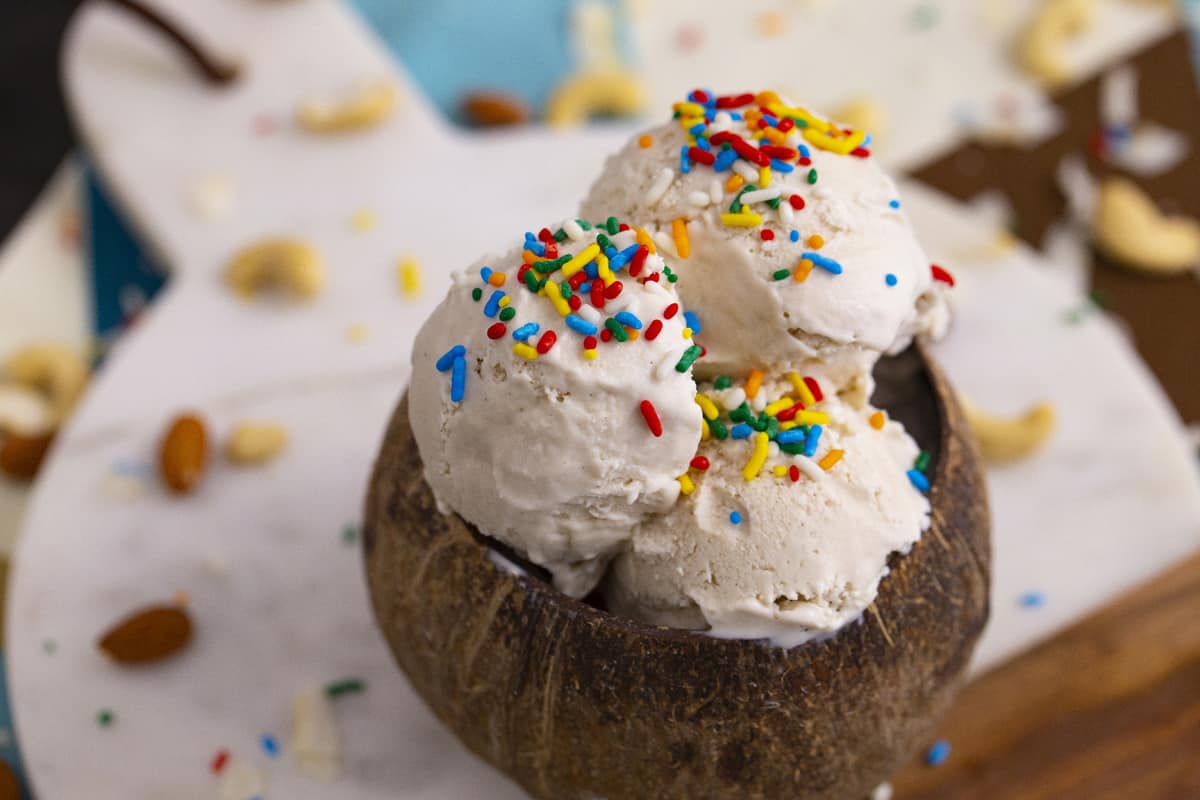Dive into the creamy, dreamy world of homemade vegan ice cream! Forget artificial flavors and questionable ingredients; this guide unveils the secrets to crafting luxuriously smooth, intensely flavorful vegan ice cream from the comfort of your kitchen. Whether you’re a seasoned vegan chef or a curious beginner, we’ll explore a variety of techniques and recipes, from simple no-churn methods to more advanced techniques for achieving that perfect texture. Get ready to tantalize your taste buds with naturally sweet, allergy-friendly options, and discover endless flavor possibilities!
We’ll cover everything from choosing the perfect plant-based milk to mastering the art of incorporating mix-ins. Learn how to create a variety of delicious flavors, from classic vanilla bean to adventurous matcha and strawberry swirl. Each recipe is designed to be adaptable to your dietary needs and preferences, ensuring a truly personalized ice cream experience. Prepare for a journey filled with delightful discoveries and the satisfying reward of crafting your own irresistible vegan ice cream masterpiece.
Step-by-Step Guide for a Specific Recipe
This guide details the creation of a creamy, dreamy vanilla bean vegan ice cream using a simple no-churn method. No ice cream maker is required, making this recipe accessible to everyone. The result is a rich, intensely flavored ice cream that rivals store-bought varieties.
Ingredients and Preparation
Before we begin the actual ice cream making process, gathering and preparing the ingredients is crucial for a smooth and successful outcome. This involves measuring out all the ingredients accurately and ensuring that the coconut cream is properly chilled. Precise measurements are key to achieving the desired texture and consistency.
- Gather Ingredients: Imagine a pristine countertop, neatly arranged with two cups of full-fat coconut milk, meticulously measured and poured into a bowl. Next to it, a cup of granulated sugar, its glistening crystals catching the light. A teaspoon of pure vanilla extract, its amber hue promising a rich flavor, sits alongside. Finally, the star of the show: one vanilla bean, its dark pod promising an intense vanilla flavor. The image is one of meticulous preparation, ready for transformation.
- Chill the Coconut Cream: The coconut milk needs to be thoroughly chilled for at least 12 hours, preferably overnight. Picture the cans of coconut milk, their smooth surfaces gleaming, sitting upright in the refrigerator, perfectly aligned. This chilling process is essential as it allows the cream to separate from the liquid, resulting in a thicker, richer ice cream base.
- Scrape the Vanilla Bean: Carefully slice open the vanilla bean lengthwise using a sharp knife. Visualize the rich, dark pod splitting open, revealing tiny black specks of vanilla seeds. Using the back of the knife, scrape the seeds from the pod, collecting them in a small bowl. The aroma of pure vanilla fills the air. These seeds contribute significantly to the ice cream’s intense flavor.
Combining the Ingredients
This stage focuses on gently blending the ingredients together to create a smooth and homogenous mixture. Avoid overmixing, which can incorporate too much air and result in a less creamy final product.
- Combine Coconut Cream and Sugar: Picture a large mixing bowl, its polished surface reflecting the light. Gently whisk together the chilled coconut cream (the thick, solidified portion from the top of the chilled cans) and the granulated sugar until the sugar is completely dissolved. The mixture should be smooth and creamy, like whipped cream. The image suggests careful, slow movements, avoiding any vigorous stirring that could incorporate excess air.
- Incorporate Vanilla: Gently stir in both the vanilla bean seeds and the vanilla extract. The image shows the subtle swirling motion of the spoon, gently incorporating the dark vanilla seeds and the amber liquid into the creamy white mixture. The combined vanilla flavor intensifies, filling the kitchen with its rich aroma.
Freezing and Serving
The final stages involve freezing the mixture and serving the delicious result. The freezing process requires patience and attention to detail to prevent ice crystal formation.
- Pour into a Container: Carefully pour the vanilla mixture into a freezer-safe container. The image shows the smooth, creamy mixture being carefully poured into a rectangular container, ensuring even distribution. The container is then tightly covered to prevent ice crystals from forming during freezing.
- Freeze: Place the covered container in the freezer for at least 6 hours, or preferably overnight. The image displays the container nestled amongst other frozen items in a well-organized freezer. The longer freezing time allows for a smoother, more consistent texture.
- Add Mix-ins (Optional): For added indulgence, mix-ins like chocolate chips or chopped fruit can be added. This is best done about 30 minutes before serving. Gently fold in your desired mix-ins, ensuring they are evenly distributed throughout the ice cream. Imagine a spoonful of perfectly melted chocolate chips swirling into the creamy vanilla base, or vibrant chunks of fresh berries adding pops of color and flavor. The addition of mix-ins transforms the basic vanilla ice cream into a customized culinary masterpiece.
- Serve and Enjoy: Once frozen, allow the ice cream to soften slightly at room temperature before scooping and serving. The final image shows a beautifully presented scoop of vanilla bean vegan ice cream, garnished perhaps with a few fresh berries or a sprinkle of chocolate shavings. The creamy texture is evident, the vanilla bean specks visible, and the overall presentation is visually appealing and appetizing.
Storage and Serving Suggestions

Preserving the creamy texture and delightful flavor of your homemade vegan ice cream requires careful storage, while creative serving ideas elevate the simple scoop into a memorable dessert experience. Proper storage prevents the formation of unsightly ice crystals and maintains the ice cream’s smooth, delectable consistency. Clever presentation and pairings amplify the sensory pleasure, transforming a homemade treat into a culinary masterpiece.
Proper storage is key to maintaining the quality of your homemade vegan ice cream. Air exposure leads to freezer burn, resulting in a dry, icy texture. Crystallization is another common issue, often caused by temperature fluctuations. To prevent these issues, airtight containers are essential.
Ice Cream Storage Methods
Transfer your freshly made vegan ice cream into an airtight container, leaving minimal headspace to reduce air exposure. Ideally, use a shallow, wide container for faster freezing and thawing. This ensures even freezing and minimizes the formation of large ice crystals. For optimal storage, place the container in the coldest part of your freezer, away from the door, where temperature fluctuations are minimized. Properly stored, your vegan ice cream should retain its quality for up to two months. However, for the best flavor and texture, consume it within three to four weeks. Imagine the rich, creamy texture, perfectly preserved, a testament to your careful storage.
Creative Serving Suggestions
Elevate your homemade vegan ice cream with a variety of delightful toppings and pairings. Consider a classic combination of warm, gooey chocolate sauce cascading over a scoop of vanilla bean ice cream, the contrast in temperatures creating a symphony of textures and flavors. A vibrant berry compote, homemade or store-bought, adds a refreshing tartness that cuts through the richness of the ice cream. For a sophisticated touch, drizzle a homemade caramel sauce, its glossy sheen reflecting the light, adding a layer of sweetness and complexity. Chopped nuts, like toasted pecans or crunchy almonds, provide a textural counterpoint, adding a satisfying crunch.
Visually Appealing Presentation
The presentation of your vegan ice cream is just as important as its taste. For a classic sundae, use a tall, elegant glass. Start with a layer of ice cream, followed by your chosen toppings, creating a visually stunning layered dessert. A swirl of chocolate sauce, a scattering of fresh berries, and a sprinkle of chopped nuts create a visually appealing and delicious dessert. Alternatively, serve scoops of ice cream in a shallow bowl, arranging the scoops artfully. Garnish with a sprig of mint, a dusting of cocoa powder, or a few chocolate shavings for an elegant touch. Imagine the smooth, creamy texture contrasting with the vibrant colors of the toppings, creating a visually stunning and delicious treat. The carefully arranged scoops, each reflecting the light, present a masterpiece of homemade ice cream artistry.
Making vegan ice cream at home is a rewarding culinary adventure, offering a delightful blend of creativity and delicious results. From the simple satisfaction of using fresh, wholesome ingredients to the joy of experimenting with unique flavors and textures, the journey is as sweet as the final product. So, gather your ingredients, embrace the process, and prepare to indulge in a guilt-free, utterly delicious treat that you crafted with your own two hands. The possibilities are as endless as your imagination, so get creative and enjoy the journey to your perfect scoop!
Clarifying Questions
What kind of ice cream maker is best for vegan ice cream?
Both compressor and canister-style ice cream makers work well. Compressor models are generally faster and more consistent, while canister-style models require pre-freezing.
Can I freeze vegan ice cream in a regular freezer?
Yes, but using an airtight container is crucial to prevent freezer burn and ice crystal formation. Consider lining the container with parchment paper for easier removal.
How long does homemade vegan ice cream last?
Properly stored in an airtight container in the freezer, homemade vegan ice cream can last for 2-3 months.
What are some good vegan ice cream substitutes for common allergens?
For nut allergies, consider sunflower seed butter or soy-based recipes. For soy allergies, explore coconut cream or oat milk bases. Always carefully check ingredient labels.


